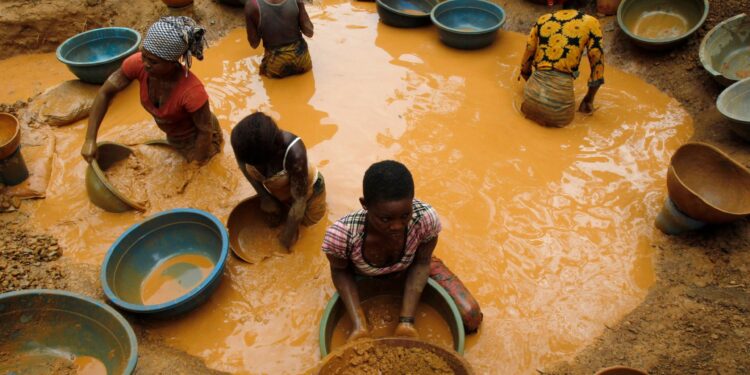2/19/2025
Through hundreds of thousands of years, the West Africa region remained the center of many precious minerals in the Adem of its major desert and in its diverse land.
There are many gold mines that have been famous for that region since the history of the ancient Ghana Empire, and the Kingdom of Mali, known as the “Kingdom of Gold”, which is famous for the stories of Mansi bin Musa (the king of gold), whose journey to the Hajj created strange stories from the world of novels and narration, because of what he had from The precious metal.
Since those distant centuries, the region has been the title of gold excavation, and a center for its trade through the caravan routes of the Sahara Road.
In the current era, the West Africa region contains a large stock of gold reserves, and its production reaches 10% of the total global production.
How did gold be found in the region?
In his answer to a question for the “Africa Conversation” website on how gold is present, geologist Raymond Kazabwe says that this mineral is like all elements, through severe energy reactions that occurred in different cosmic and space environments with the beginning of the universe formed 13 billion years ago.
Raymond says that there are two theories of the formation of the yellow metal and the beginning of its existence, one of which is called cumulative tecttuate, and requires that large quantities of gold were deposited in certain places where the continents were expanding and changing their pattern 3 billion years ago.
Another theory indicates that at the beginning of the Panozoic era was formed when the Earth was filled with oxygen, and during this stage, geological processes, changes in temperature and pressure caused the formation of gold deposits that can be extracted.
In the West Africa region, gold deposits were formed in the “Kraton” areas, which consists of fixed parts from inside the Earth and includes rocks and shield platforms on the land surface.
Gold deposits were formed in the “Kraton” rocks in West Africa from about 2.3 to 2.4 billion years, through temperatures and tectonic conditions.
Gold located in West Africa, especially Ghana, Mali, Mauritania, Senegal, Ivory Coast and Burkina Faso, and most of these countries, constitute 50% of its land as a place for the deposits of this mineral.
Mali and Ghana are one of the most rich West African countries in gold, as their production constitutes about 57% of the total production and resources of the region.
It is believed that Ghana has a gold reserve of 1000 metric tons, and annually produces a total of 90 metric tons.
As for Mali, its production for the year 2023 reached 67.7 tons, but it declined in 2024 to 51 tons due to the dispute with foreign companies, and its reserves are estimated at about 800 tons.
These production numbers remain modest compared to what China and Australia are classified at the forefront of gold producing countries worldwide.
The production of the People’s Republic of China in 2023 reached 370 metric tons, and the production threshold in Australia reached 310 tons.
Primitive excavation
In the past, the most famous means of finding gold was exploration by rivers, torrents and water effects near mountain slopes to obtain small particles.
Scientific and technological progress has simplified exploration and reduce production and time costs in extracting operations.
Despite the great development in the means of production, the sum of the countries of the West Africa region are still dependent on old and initial exploration means, where citizens practice drilling and stones ’son -in -law to extract gold, and these traditional methods often cause environmental and humanitarian disasters.
In Mali, Mauritania and Guinea, there are many incidents of the collapse of excavation wells that cause the death and injury of many people, and governments have not taken strict measures to prevent civil excavation, nor did they establish national excavation companies that have modern means to extract wealth.
The looted wealth
In large and golden mines, governments resort to the use of foreign companies, the contracts are often largely unfair.
In Mauritania, which became one of the gold exporters, the state’s share does not exceed 6.5% of the Tazias mine, which produced 622 thousand and 394 ounces in 2024, which previously caused a large debate in the political scene, in which the opposition accused the regime of making corruption deals and contracts from below The table.
In the year 2020, voices rose from within the Mauritanian parliament calling for the nationalization of the Canadian company “Kenros Gold”, considering that it is looting the country’s wealth for free.
In the Sahel region, which was recently ruled by military councils, it began negotiating to raise their proportions with foreign companies, which raised a crisis between the financial government and the company “Barrick Gold”.
In 2023, the government in Bamako approved a mining law to raise the state’s ratio to 30% in all new extraction operations, and also canceled the tax lifting law that was benefiting from gold mining companies.
In the same context, the authorities in Mali in the beginning of 2024 Yatila mine in the Kais region, which was run by two companies from South Africa and Canada, were specialized in the country.
With the beginning of 2024, the head of the transitional phase in Burkinafasu, Captain Ibrahim Traore, announced the cancellation of some licenses granted to gold mining companies in his country.
On the way to working to restore the wealth of gold, the government in Burkina Faso in February 2024 acquired the stock of Simavo Burkinafaso Gold Mining.
Military governments in the African Sahel region aim to pressure on foreign mining companies to find a fair distribution of gold wealth to contribute to alleviating the suffering of the population.



